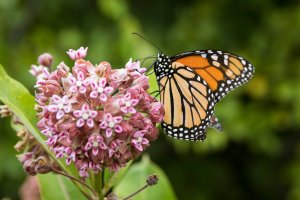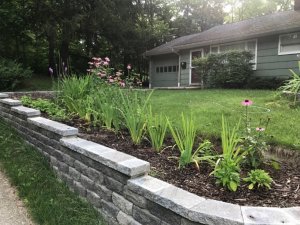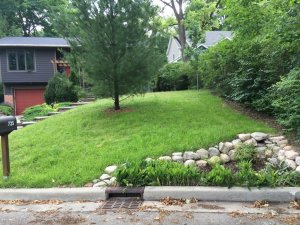No-Mow May is not just a catchy phrase… it is a mindset!
March 13, 2024
By Ali Groulx, Park Interpreter
What would it look like if we all let our lawns grow wild? Maybe you imagine a yard covered by the sunny heads of dandelions or black medic, or the tufts of delicate clover flowers surrounded by three leafed stems. Perhaps you picture tall grasses gone to seed, their wheat-like structures hosting all sorts of hidden animals. Creating a biodiverse, desirable habitat is beneficial not only for wildlife, but for your mental health, too! While it is tempting to lock away your lawn mower for the entirety of “No-Mow May,” that is not the only solution. In exchange for your time and elbow grease, you can encourage the growth of beneficial, native plants. It all depends on what you are comfortable with, but no matter big or small, promoting our native plants is a high value effort for the environment, humans, and animals alike.
imagine a yard covered by the sunny heads of dandelions or black medic, or the tufts of delicate clover flowers surrounded by three leafed stems. Perhaps you picture tall grasses gone to seed, their wheat-like structures hosting all sorts of hidden animals. Creating a biodiverse, desirable habitat is beneficial not only for wildlife, but for your mental health, too! While it is tempting to lock away your lawn mower for the entirety of “No-Mow May,” that is not the only solution. In exchange for your time and elbow grease, you can encourage the growth of beneficial, native plants. It all depends on what you are comfortable with, but no matter big or small, promoting our native plants is a high value effort for the environment, humans, and animals alike.
Many use the term weed to refer to ANY plant growing where you do not want it to… but not all ‘weeds’ are bad! Did you know that our native milkweed is classified as a noxious weed by the State of Michigan? An act passed in 1941 permits eradication of common weeds like Canada thistle and poison ivy, but also includes milkweed. This plant, and all plants in the genus Asclepias, are native, beneficial host plants the monarch butterfly. In fact, Michigan is a haven for monarch butterflies, especially as the climate shifts. Recently, House Bill 4857 has been created to exempt milkweed from the 1941 act, and you can read more about its progress here. Short, uniform turf grass is often a monoculture, a place where only one species of plant can be found. This can decimate an ecosystem’s natural biodiversity. It is true that some animals like robins, cowbirds, and northern flickers appreciate yards like these, making it easier for these birds to forage for insects and worms.

Canada geese, moles, and thirteen-lined ground squirrels like short grass, too, but they may become a problem with their scat or burrowing habits. A yard with a healthy balance of mowed grass and longer, natural growing areas can sustain a higher diversity of life and reduce the feelings of despair when you realize that burrowing animals love a manicured lawn. The city of Ann Arbor has been planting the way when it comes to encouraging a healthy balance between turf and native plantings in communities. After trial and error, what used to be called “no-mow May” has more accurately morphed into “Pollinator-Aware Lawn Care.” This type of lawn care is something that anyone can do. By harnessing the power of deeply rooted native plants and flowers like milkweed, you can improve the quality of life for our pollinator friends like the Monarch.
Implementing qualities of “Pollinator-Aware Lawn Care” can create a measurable impact, protecting our ground water and promoting species richness. While turf grass can become easily stressed by the scorching sun or overly wet conditions, there are native alternatives that truly thrive in these types of environments. Consider the downspout coming off your home – what if you could harness this water for irrigation? As the downspout guides water off your roof, you can help send that water straight back into the ground by planting deeply rooted native plants. As a bonus, the plants will filter harmful substances that may have been picked up along the water’s journey. The long roots suck up the water, like a natural sponge, and put it right back into the water table. Regular grass has short roots and cannot ‘drink’ as much as their native predecessors can. Gardens specifically planted for storm water management are called rain gardens. There are opprotunities to learn how to garden like a pro by participating in a Master Rain Gardener course. Look out for an announcement or keep an eye on your Metroparks calendar – new courses will continue in August, with options for in-person or online classes. In the meantime, you can visit The Friends of the Rouge master rain gardener page to learn more about rain gardens.
If you wish to convert turf grass to native plantings and rain gardens, you must prepare in advance. Luckily, it can be as simple or as difficult as you choose. A simple way of conversion is to wet the ground, lay down a triple layer of cardboard, and pile on a thick layer of mulch. You can sign up for a free chip drop, which connects you with a local tree company that will bring you a load of fresh mulch from a recent job. A layer of woodchips will kill off the grass underneath, and the cardboard will break down to become a part of the soil. After a few months have passed, you can dig some holes and insert plants of your choosing, whether you start them from seed, or get them from a local garden club sale. Making your natural, native areas look intentional is an important part of the upkeep when it comes to growing wild. Be sure to check your local ordinances for any lawn-related rules or regulations! Allowing your lawn to grow taller or converting patches to native plantings means an increase in insect activity, but do not worry; the animals they feed will do most of the bug control for you. With the warmer winter weather this year, ticks have been seen earlier than usual, but there are many ways to mitigate these unwanted pests. Creating pathways through your yard can reduce the likelihood of ticks finding their way onto you or your pet. By keeping edges low and managing taller vegetation around high traffic areas, it reduces the tick’s opportunities to hitch hike. It is always good practice to conduct tick checks on yourself, your family, and your pets after exploring outside.
Any effort to create natural spaces in our yards can help our insect population. We depend on pollinators to help produce food, and we value them for their beauty, too. You may be surprised by the new animals your no-mow patch may attract; from swallows and sparrows to monarchs and fireflies, there are many species that you can support by letting your yard grow a bit wild. Just be sure to trim your edges and make your natural areas look intentional, and consider collaborating with your neighbors or making a sign to let everyone know why your lawn has been transformed into a beautiful, cozy habitat for our native wildlife.

